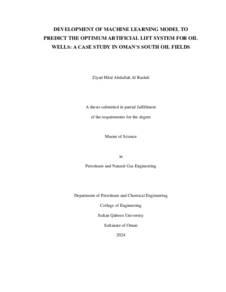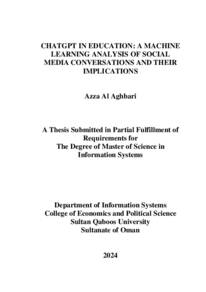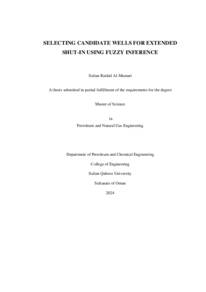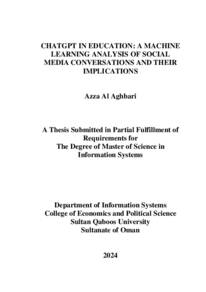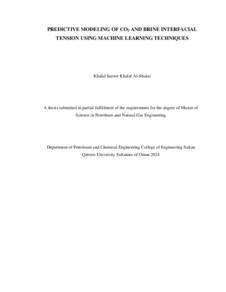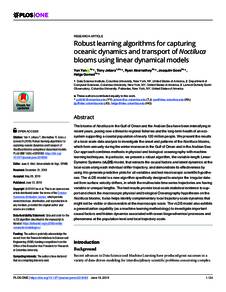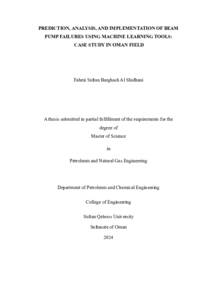Document
Development of machine learning model to predict the optimum artificial lift system for oil wells : a case study in Oman’s south oil fields.
Source
Master's thesis
Other titles
تطوير نموذج التعلم الآلي للتنبؤ بنظام الرفع الاصطناعي الأمثل لآبار النفط : دراسة حالة في حقول النفط في جنوب عمان
Country
Oman
City
Muscat
Publisher
Sultan Qaboos University
Gregorian
2024
Language
English
Thesis Type
Master's thesis
English abstract
The life cycle of an oil production well can be divided into several stages, from exploration
to abandonment. Each stage serves a specific purpose and involves different activities and
considerations. Production cycle is one of the important stage where the well begins to
flow and produce economically. At this stage, production rates are monitored, and
reservoir management strategies are implemented to maximize the recovery and minimize
well decline. At the initial production, most of the wells are naturally flowing by rely on
natural reservoir pressure to bring oil to the surface. Most of these wells produced at lower
operating costs. By the time, the reservoir pressure is declined and considered as
insufficient to bring the oil to the surface effectively. Here, the Artificial Lift systems are
implemented to enhance production rates and deplete the natural pressure. They help
maintain or increase production levels by providing the necessary energy to bring oil to
the surface. These wells tend to have higher operational costs due to the energy required
to power the artificial lift mechanisms, and they may require more maintenance and
monitoring to ensure efficient and consistent production. Selecting the appropriate
artificial lift system is an important decision in this process, as it significantly impacts
well productivity and operational costs. Traditional methods for choosing the optimal lift
system often depends on empirical data and experts knowledge, making the process timeconsuming and sometimes suboptimal which can lead into higher operational costs. To
address this challenge, the present study proposes a development and implementation of
Machine Learning (ML) model to predict the most suitable artificial lift system for
individual oil wells in South Oman Fields. The study began by collecting the wells
completion and production data for almost 995 horizontal produces operated with four
types of Artificial Lift Systems (ALS) in the field. The data has been cleaned to build up
the model and validated it to make it ready for the deployment. Feature engineering and
data preprocessing are conducted to ensure the quality and relevance of input data. By
applying six machine learning classification algorithms, including Decision Tree, KNearest Neighbors, Random Forest, Support Victor Machines, Naïve Bayes and Logistic
Regression we learned to identify patterns and relationships between well attributes and
the optimum lift systems. The Thesis aims to improve the decision-making process by
providing a data-driven approach that can assist operators and fresh engineers in selecting
the optimum artificial lift system for a given well. The results of this research were
excellent as four algorithms scores an accuracy higher than 95% at a split ratio of (70:30,
Train: Test) which makes the model reliable be used in future applications.
Arabic abstract
يمكن تقسيم دورة حياة بئر إنتاج النفط إلى عدة مراحل، بد ًءا من الاستكشاف وحتى الهجر. تخدم كل مرحلة غرضا محددًا وتتضمن أنشطة واعتبارات مختلفة. تعتبر دورة الانتاج من المراحل المهمة التي يبدأ فيها تدفق البئر وإنتاجه بشكل اقتصادي. في هذه المرحلة، تتم مراقبة معدلات الانتاج، ويتم تنفيذ استراتيجيات إدارة الخزان لتحقيق أقصى قدر من الاستخراج وتقليل تراجع انتاج الابار. في مرحلة الانتاج الاولي، تتدفق معظم الابار بشكل طبيعي من خالل الاعتماد على ضغط المكمن الطبيعي لجلب النفط إلى السطح. ويتم إنتاج معظم هذه الابار بتكاليف تشغيل قليلة. وبحلول الوقت، ينخفض ضغط المكمن ويعتبر غير كاف إليصال النفط إلى السطح بشكل فعال. هنا يتم تطبيق أنظمة الرفع الاصطناعي لتعزيز معدلات الانتاج واستنزاف الضغط الطبيعي. فهي تساعد في الحفاظ على مستويات الانتاج أو زيادتها من خالل توفير الطاقة الالزمة لجلب النفط إلى السطح. تميل هذه الابار إلى أن تكون تكاليف تشغيلها أعلى بسبب الطاقة الالزمة لتشغيل آليات الرفع الاصطناعي، وقد تتطلب المزيد من الصيانة والمراقبة لضمان إنتاج فعال ومتسق. يعد اختيار نظام الرفع الاصطناعي المناسب قرا ًرا مهًما في هذه العملية، ألنه يؤثر بشكل كبير على إنتاجية البئر وتكاليف التشغيل. غالبًا ما تعتمد الطرق التقليدية الختيار نظام الرفع الامثل على البيانات التجريبية ومعارف ، مما يجعل العملية تستغرق وقتًا طويالً الخبراء وأحيانًا دون المستوى الامثل مما قد يؤدي إلى ارتفاع تكاليف التشغيل. ولمواجهة هذا التحدي، تقترح الدراسة الحالية تطوير وتنفيذ نموذج التعلم الالي )ML )للتنبؤ بنظام الرفع الاصطناعي الاكثر مالءمة لكل بئر نفط في حقول جنوب عمان. بدأت الدراسة بجمع بيانات استكمال الابار والانتاج لما يقرب من 995 آبار أفقية يتم تشغيلها بأربعة أنواع من أنظمة الرفع الاصطناعي )ALS )في الحقل. تم تنظيف البيانات لبناء النموذج والتحقق من صحته لجعله جاه ًزا للنشر. يتم إجراء هندسة الميزات والمعالجة المسبقة للبيانات لضمان جودة البيانات المدخلة ومالءمتها. من خالل تطبيق ستة خوارزميات لتصنيف التعلم الالي، بما في ذلك Tree Decision، ،Naïve Bayesو ،Support Victor Machinesو ،Random Forestو ،K-Nearest Neighborsو وRegression Logistic، تعلمنا كيفية تحديد الانماط والعالقات بين سمات البئر وأنظمة الرفع المثالية. تهدف الاطروحة إلى تحسين عملية صنع القرار من خالل توفير نهج قائم على البيانات يمكن أن يساعد المشغلين والمهندسين الجدد في اختيار نظام الرفع الاصطناعي الامثل لبئر معين. وكانت نتائج هذا البحث ممتازة حيث سجلت أربعة خوارزميات دقة أعلى من %95 بنسبة انقسام )،70:30 تدريب: اختبار( مما يجعلها نماذج موثوقة يمكن استخدامها في التطبيقات المستقبلية.
Category
Theses and Dissertations

